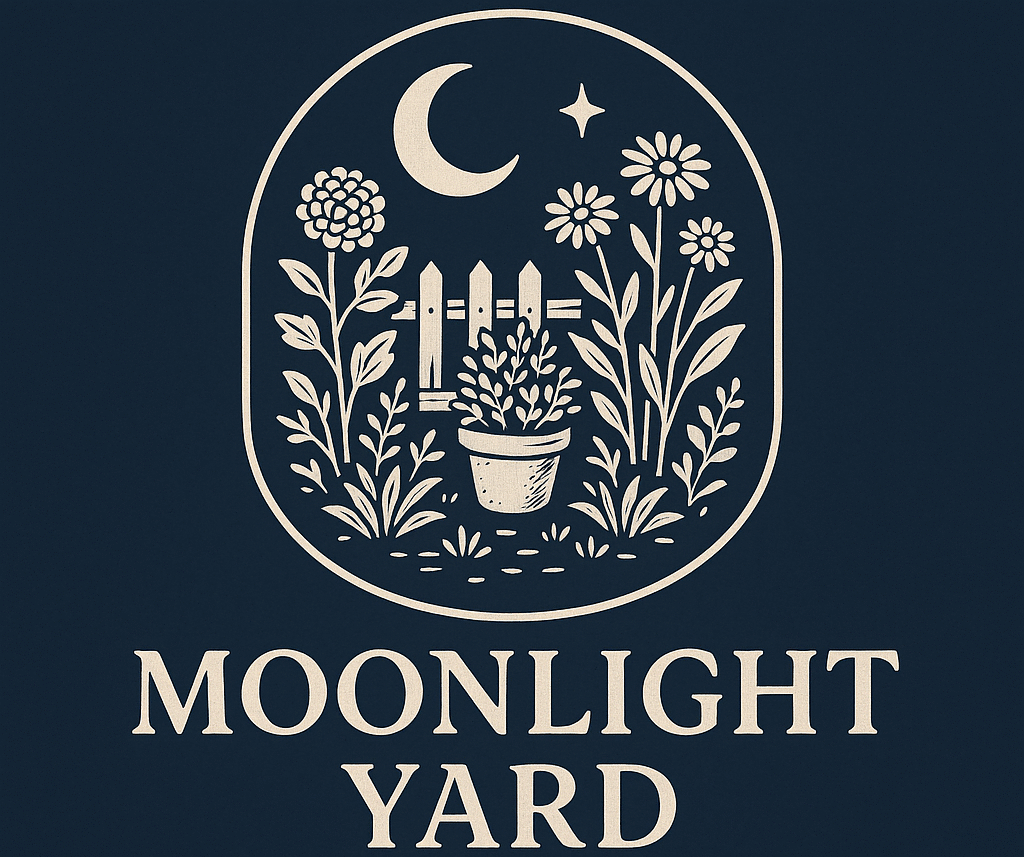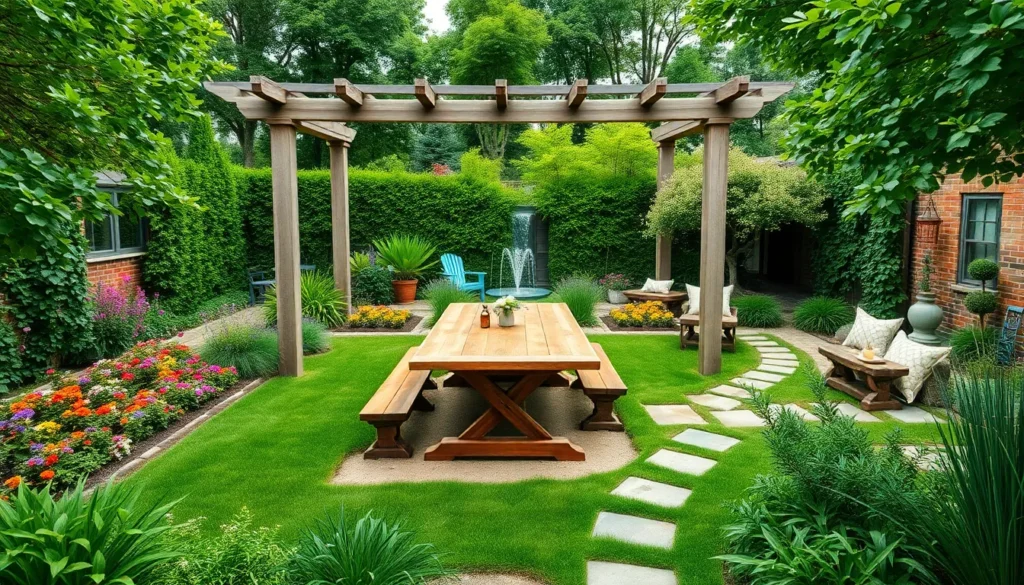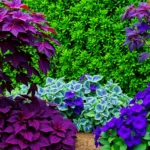Rectangular gardens present unique opportunities that many homeowners overlook. We’ve discovered that these linear spaces can become stunning outdoor sanctuaries with the right design approach and creative vision.
Most rectangular plots suffer from a common problem – they feel narrow and uninspiring. But, we’ve learned that these spaces actually offer incredible potential for creating depth, visual interest, and functional zones that rival any garden shape. The key lies in understanding how to work with the natural flow of rectangular dimensions rather than against them.
We’ll share proven strategies that transform boring rectangular gardens into captivating outdoor retreats. From clever zoning techniques that maximize every square foot to strategic plant placement that creates the illusion of width, these ideas will help you unlock your garden’s hidden potential and create a space you’ll love spending time in.
Create Defined Garden Zones for Maximum Functionality
Effective zoning transforms rectangular gardens into multifunctional outdoor spaces that serve your family’s diverse needs. We’ll explore how strategic area division maximizes every square foot of your rectangular garden while maintaining visual cohesion.
Designate Separate Areas for Dining and Relaxation
Position your dining zone near the house entrance for convenient access during meal preparation and serving. We recommend allocating 8-10 feet of width for comfortable seating arrangements, allowing chairs to pull out without crowding pathways. A pergola or overhead structure defines this space while providing shade for outdoor meals.
Create a relaxation area in the garden’s quieter section, typically the far end away from high-traffic zones. Install a fire pit or water feature as the focal point, surrounded by comfortable seating arranged in a conversational layout. Low-growing plants like hostas or ornamental grasses provide natural boundaries between dining and lounging spaces.
Use different flooring materials to visually separate these zones while maintaining flow throughout your rectangular garden. Combine stone pavers for dining areas with gravel or mulch pathways leading to softer grass or deck surfaces in relaxation zones.
Establish Dedicated Spaces for Children’s Play
Designate the sunniest area of your rectangular garden for active play equipment like swing sets or trampolines. We suggest positioning play zones where parents can supervise from both indoor and outdoor seating areas. A 12×12 foot minimum space accommodates most playground equipment while leaving room for safe movement.
Install sand or rubber mulch as ground cover beneath play structures to ensure child safety during active play. Border these areas with colorful, child-friendly plants like sunflowers or marigolds that can withstand occasional ball impacts. Consider adding raised garden beds where children can grow their own vegetables or flowers.
Create quiet play corners using natural materials like logs or boulders arranged as seating circles. These spaces encourage imaginative play while teaching children to appreciate nature within your rectangular garden design.
Plan Distinct Zones for Vegetable and Herb Growing
Allocate the morning sun area for vegetable cultivation, as most edible plants require 6-8 hours of direct sunlight daily. We recommend creating raised beds measuring 4 feet wide by 8-12 feet long, allowing easy access from both sides without soil compaction. This configuration works particularly well in rectangular gardens where length exceeds width.
Position herb gardens near kitchen access points for convenient harvesting during cooking. A dedicated 3×6 foot raised bed or container arrangement provides sufficient space for culinary essentials like basil, oregano, and thyme. Consider vertical growing systems to maximize herb production in smaller rectangular spaces.
Separate annual and perennial crops into distinct growing zones to simplify garden maintenance and crop rotation. Annual vegetables occupy beds that can be easily amended each season, while perennial herbs and fruit plants establish permanent locations along garden borders or corners.
Design Linear Pathways to Enhance Garden Flow
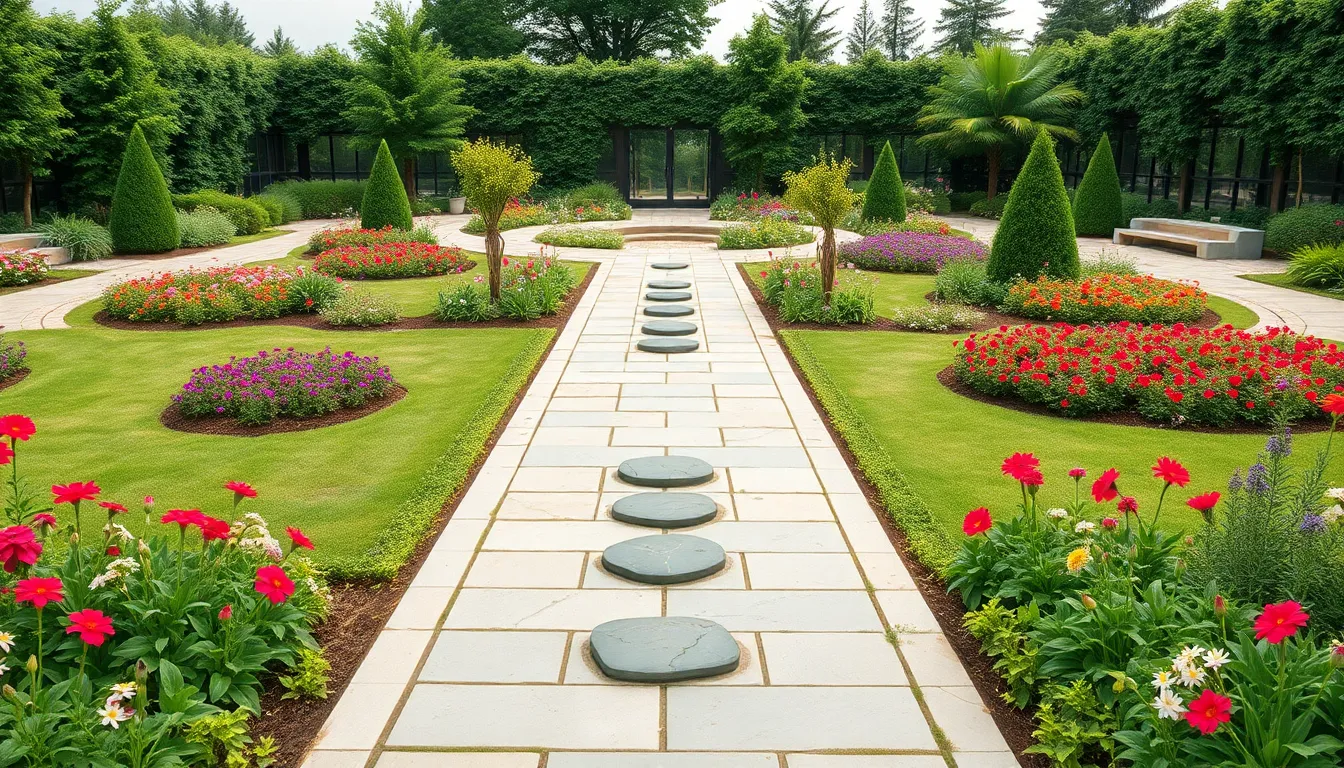
Well designed pathways transform rectangular gardens from simple outdoor spaces into flowing landscapes that guide visitors naturally through each zone. These pathways create structure while connecting different areas seamlessly.
Install Straight Central Walkways for Easy Navigation
Straight central walkways serve as the backbone of rectangular garden design by providing clear direction through your outdoor space. Installing these linear pathways creates an immediate sense of order while making navigation effortless for family members and guests.
Position your main walkway down the center or slightly off center to divide the garden into manageable sections. Materials like flagstone, brick, or concrete pavers work exceptionally well for creating durable straight paths that withstand heavy foot traffic.
Width matters significantly when designing central walkways—aim for at least 4 feet to allow two people to walk comfortably side by side. This generous sizing prevents the pathway from feeling cramped while maintaining proportional balance with your rectangular garden’s dimensions.
Create Curved Paths to Soften Rectangular Edges
Curved paths break up the angular lines that naturally dominate rectangular gardens while adding visual interest throughout your industry. These gentle curves create a more organic feel that contrasts beautifully with the structured boundaries of your space.
Design sweeping curves that flow naturally from one garden zone to another rather than sharp turns that feel forced or unnatural. Curved pathways work particularly well when connecting seating areas to vegetable beds or leading from dining spaces toward relaxation zones.
Use flexible edging materials like metal or plastic strips to create smooth curves that maintain their shape over time. Natural stone or gravel pathways adapt easily to curved designs while providing excellent drainage during rainy seasons.
Add Stepping Stone Trails Through Planting Beds
Stepping stone trails create charming pathways that weave through planted areas without disrupting root systems or requiring important excavation. These trails offer practical access for garden maintenance while adding decorative elements that enhance visual appeal.
Space stepping stones approximately 18 to 24 inches apart to accommodate comfortable walking strides for most adults. This spacing allows ground cover plants to grow between stones while maintaining easy navigation through dense planting beds.
Choose stepping stones that complement your garden’s overall aesthetic—natural flagstone works beautifully in cottage style gardens while concrete pavers suit modern rectangular designs. Install each stone level with the surrounding soil to prevent tripping hazards and ensure long term stability.
Build Vertical Elements to Add Height and Interest
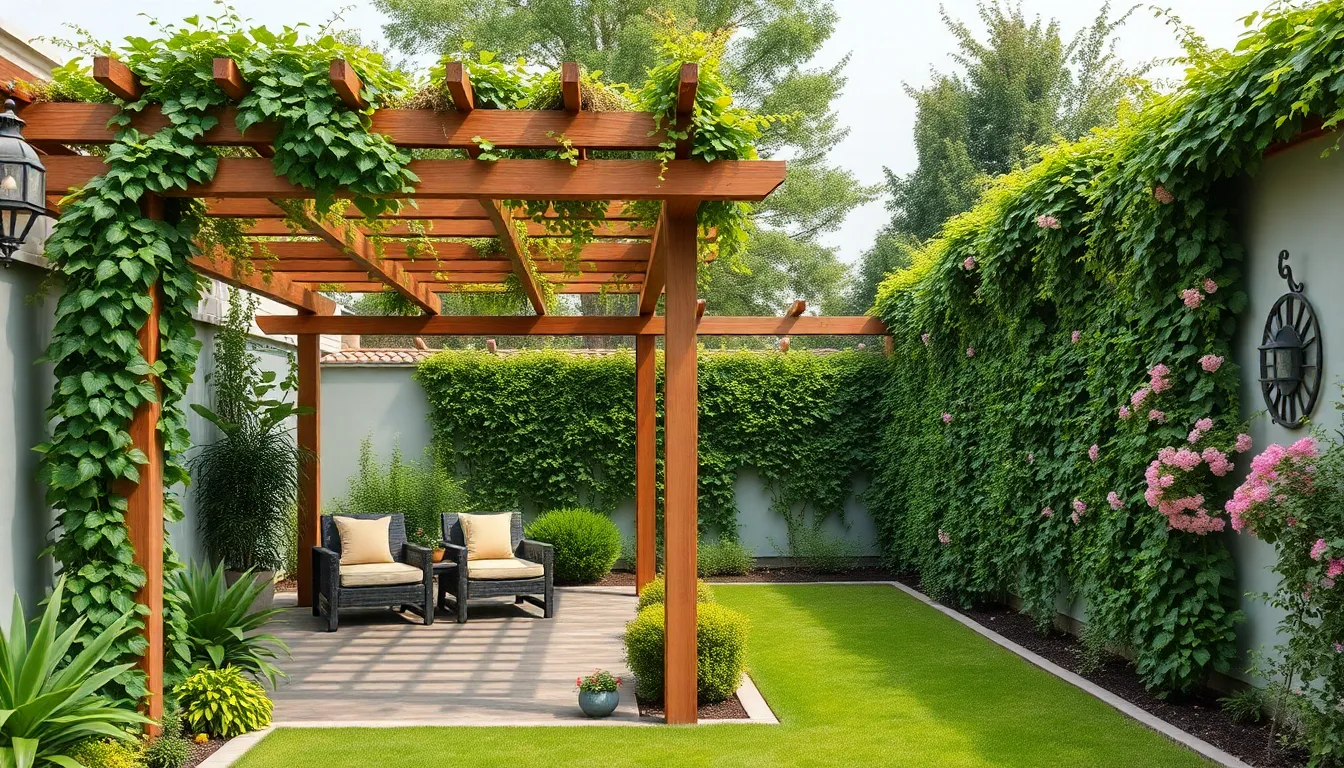
Vertical elements transform rectangular gardens by drawing the eye upward and creating visual depth that breaks up monotonous horizontal lines. These structures maximize our growing space while adding architectural interest to otherwise flat landscapes.
Construct Trellises Along Fence Lines
Trellises along fence lines create instant vertical growing space for climbing plants like ivy or clematis. We can install wooden or metal trellis panels directly onto existing fences to support vigorous climbers that’ll soften harsh boundary lines. Position trellises at 6-foot intervals for optimal plant coverage and structural support.
Choose materials that complement our garden’s aesthetic – cedar trellises offer natural warmth while powder-coated steel provides modern appeal. Install these structures with sturdy brackets that can handle the weight of mature climbing plants and seasonal weather conditions.
Install Pergolas for Overhead Garden Structure
Pergolas provide essential overhead structure that defines outdoor living spaces while offering partial shade and vertical growing opportunities. We can position these structures over seating areas or pathways to create intimate garden rooms within our rectangular layout. Standard pergola dimensions of 10×12 feet accommodate most dining sets comfortably.
Modern pergola designs incorporate adjustable louvers or retractable canopies for customizable shade control throughout the day. Install these structures with concrete footings for stability and consider adding electrical wiring for future lighting or fan installations.
Plant Climbing Vines on Garden Walls
Garden walls become living canvases when we plant climbing vines that transform blank vertical surfaces into lush green backdrops. Select fast-growing varieties like Boston ivy or Virginia creeper for quick coverage, or choose flowering climbers like jasmine or honeysuckle for seasonal color and fragrance.
Prepare wall surfaces with wire support systems or climbing aids placed 12-18 inches from the wall to allow proper air circulation. Plant vines 2-3 feet apart at the base of walls and provide initial training on support structures until established growth takes over.
Establish Symmetrical Planting Schemes for Visual Balance
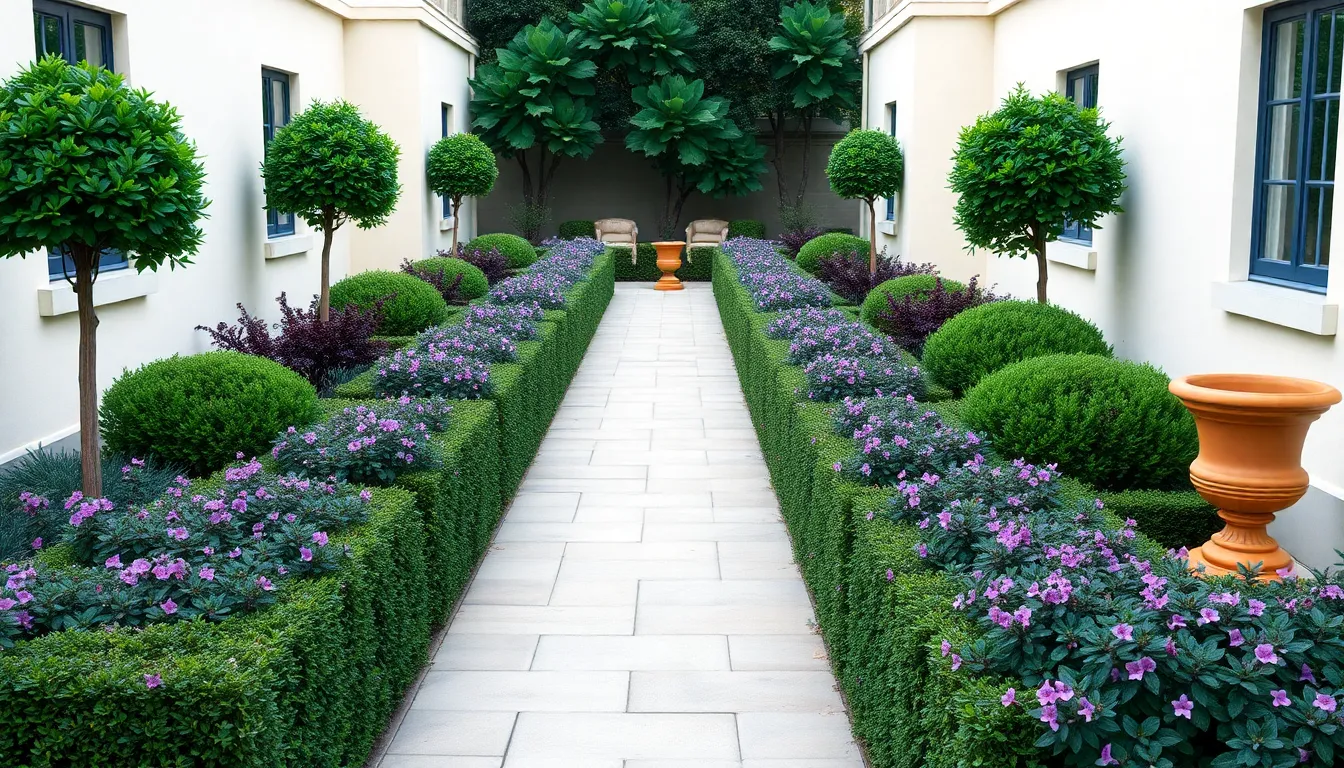
Symmetrical planting schemes create visual harmony and transform rectangular gardens into sophisticated outdoor spaces. We can achieve this balance through strategic plant placement and thoughtful design choices that enhance the garden’s natural geometry.
Mirror Plant Arrangements on Opposite Sides
Positioning identical plants or plant arrangements on opposite sides of our rectangular garden creates an immediate sense of symmetry and visual balance. We place matching shrubs like boxwood or lavender at corresponding points along the garden’s length to frame the space beautifully.
Repeating plant groupings on both sides establishes rhythm throughout the garden design. We select three to five specimens of the same variety and position them at equal intervals along parallel borders. This technique works particularly well with ornamental grasses like fountain grass or decorative plants such as hostas.
Anchoring corners with matching statement plants creates strong focal points that draw the eye through the entire space. We might choose specimen trees like Japanese maples or large architectural plants like yucca to mark the garden’s boundaries while maintaining perfect symmetry.
Create Balanced Color Schemes Throughout the Space
Developing a balanced color palette enhances our rectangular garden’s aesthetic appeal and creates visual cohesion across the entire space. We distribute complementary colors evenly throughout the garden to prevent any single area from overwhelming the design.
Using the rule of three helps us create harmonious color combinations that feel natural and pleasing. We select one dominant color like deep green foliage, add a secondary color such as purple flowers, and include accent colors like white or yellow blooms to create depth and interest.
Seasonal color planning ensures our garden maintains balance throughout the year. We incorporate spring bulbs like tulips and daffodils, summer perennials such as coneflowers and black-eyed Susans, and fall plants like chrysanthemums to provide continuous color rotation.
Use Matching Planters and Garden Containers
Uniform planters and containers add to the symmetrical look while helping us maintain a cohesive design throughout our rectangular garden. We select containers that complement our home’s architectural style and repeat them at regular intervals along pathways or borders.
Choosing planters in similar materials creates visual continuity that ties the entire garden together. We might use matching terracotta pots for Mediterranean-style gardens or sleek metal containers for contemporary outdoor spaces. This consistency helps our rectangular garden feel intentionally designed rather than randomly planted.
Varying container sizes while maintaining the same style adds visual interest without breaking the symmetrical theme. We use larger planters as anchor points at garden entrances or corners, medium-sized containers along borders, and smaller pots to fill gaps or highlight exact areas.
Incorporate Water Features to Create Focal Points

Water features transform rectangular gardens by serving as natural eye-catchers that draw attention and anchor the entire space. We can strategically position these elements to break up the linear flow while creating inviting gathering spots throughout our garden design.
Install Rectangle-Shaped Ponds or Fountains
Rectangle-shaped water features maintain our garden’s clean geometric lines while adding ever-changing visual interest. We recommend placing these structured elements symmetrically along the garden’s length to reinforce the existing geometry and create a modern, sophisticated look.
Stone or concrete borders work exceptionally well with rectangular ponds because they harmonize with the structured layout we’re already working with. Central placement creates the strongest focal point impact, naturally drawing visitors toward the feature and encouraging them to pause and appreciate the space.
For contemporary appeal, we can offset rectangular fountains to one side rather than centering them completely. This approach adds visual tension while maintaining the clean lines that make rectangular gardens so appealing to modern homeowners.
Add Small Water Gardens in Corner Spaces
Corner spaces in rectangular gardens often remain underutilized, but small water gardens transform these neglected areas into charming focal points. We suggest installing self-contained fountains, bubbling rocks, or raised planters filled with aquatic plants to soften harsh edges and breathe life into forgotten corners.
Pairing these compact water features with lush plantings creates intimate micro-environments that feel intentionally designed rather than afterthoughts. Seating arrangements near corner water gardens encourage lingering and help us maximize every square foot of our rectangular space.
Raised corner planters with water elements work particularly well because they add vertical interest while keeping maintenance accessible. We can incorporate water lilies, cattails, or other aquatic plants to create miniature ecosystems that support local wildlife.
Create Stream-Like Water Elements Along Pathways
Stream-like water elements running alongside our pathways introduce movement and soothing sounds that make traveling through the garden more captivating. We can line these rills with natural stones or edge them with low-growing plants to blend seamlessly into our existing industry design.
These flowing features serve dual purposes by distributing water to various garden zones while creating the gentle, meditative effects that make outdoor spaces truly special. Positioning streams along pathway edges guides visitors naturally through different garden areas while maintaining clear navigation routes.
Stone-lined channels work exceptionally well because they complement the structured nature of rectangular gardens while adding organic curves and movement. We recommend varying the width and depth of these water elements to create visual interest and accommodate different plant groupings along their banks.
Maximize Corner Spaces for Additional Functionality
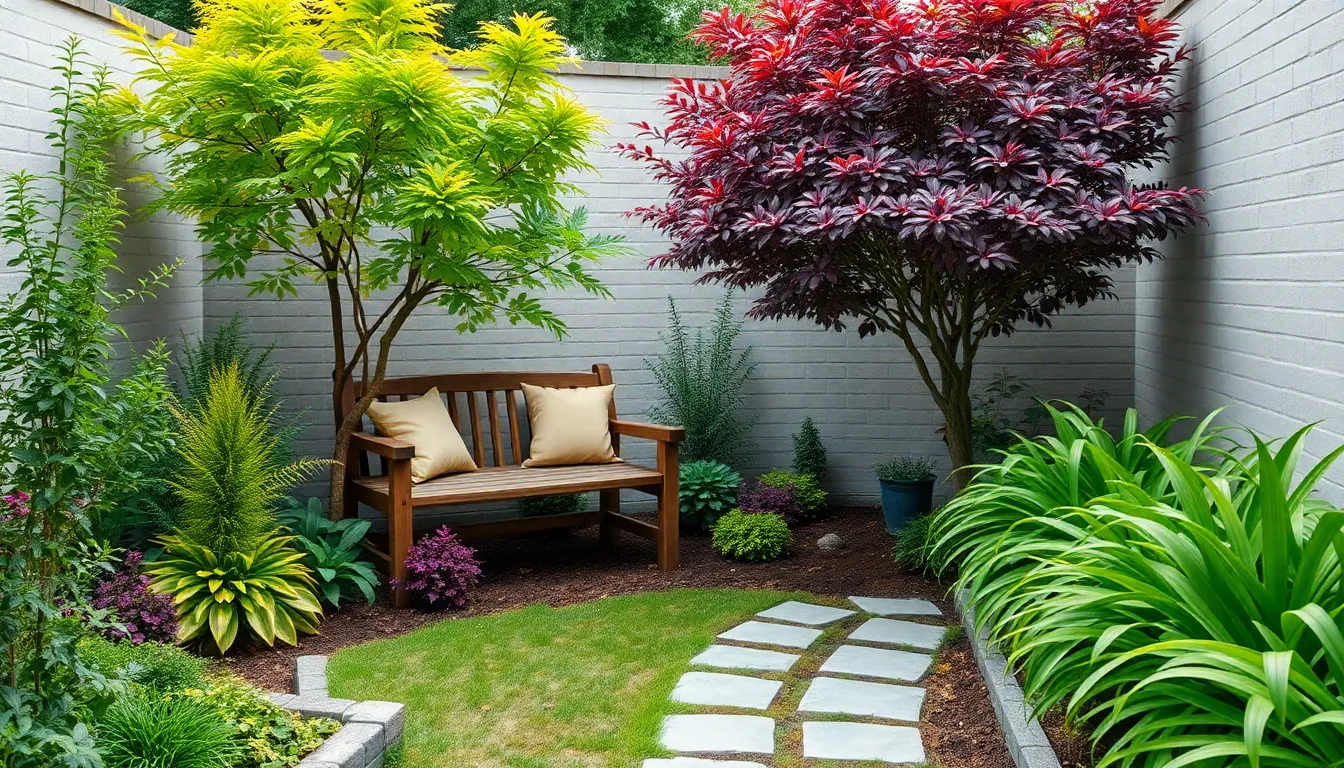
Corner spaces in rectangular gardens often remain overlooked, yet they offer incredible potential for creating functional and beautiful garden areas. We can transform these underutilized zones into the most charming and practical features of our outdoor space.
Design Cozy Seating Nooks in Garden Corners
Seating nooks in corners create intimate gathering spaces that feel naturally separated from the main garden flow. We recommend placing comfortable bench seating or bistro sets in prominent corners where they’ll receive optimal light throughout the day. These areas work exceptionally well when paired with wooden decking, which adds warmth and defines the space clearly.
Sunken seating areas provide an elevated design element that makes corner spaces feel intentionally crafted rather than leftover. We can excavate corner areas slightly and install built-in bench seating with weather-resistant cushions for year-round comfort. Adding a small side table or built-in ledge creates the perfect spot for morning coffee or evening beverages.
Stepping stone pathways should lead directly to these seating nooks to establish clear access routes while maintaining the garden’s organic flow. We suggest using natural stone or brick materials that complement the overall garden aesthetic and create visual continuity with other hardscape elements.
Plant Corner Gardens with Specimen Trees
Specimen trees in corners serve as dramatic focal points that draw the eye and create vertical interest in rectangular spaces. We recommend selecting trees with distinctive characteristics like colorful bark, interesting branching patterns, or seasonal flowers that will captivate attention throughout the year.
Strategic tree placement allows us to define separate garden zones while providing natural shade for seating areas below. Japanese maples, ornamental cherries, or small flowering trees work exceptionally well in corner positions where they won’t overwhelm the space but still command attention.
Underplanting around specimen trees creates layered garden beds that maximize every square foot of corner space. We can install shade-loving perennials, ornamental grasses, or seasonal annuals beneath the tree canopy to establish rich, textured plantings that change throughout the seasons.
Install Storage Answers in Underutilized Areas
Vertical storage systems make corner spaces work harder by providing essential garden organization without consuming valuable planting area. We can install wall-mounted shelving units, tool racks, or cabinet systems against existing fences or walls to keep garden supplies organized and easily accessible.
Hidden storage benches combine seating functionality with practical storage needs, making them perfect for corner placement. These dual-purpose pieces can house cushions, garden tools, or outdoor entertaining supplies while providing additional seating for guests during gatherings.
Living walls with storage integration offer an innovative approach that combines plant displays with functional storage compartments. We can install modular living wall systems that include built-in planters alongside storage cubbies for tools, watering supplies, or seasonal decorations.
Choose Appropriate Plants for Rectangular Garden Layouts
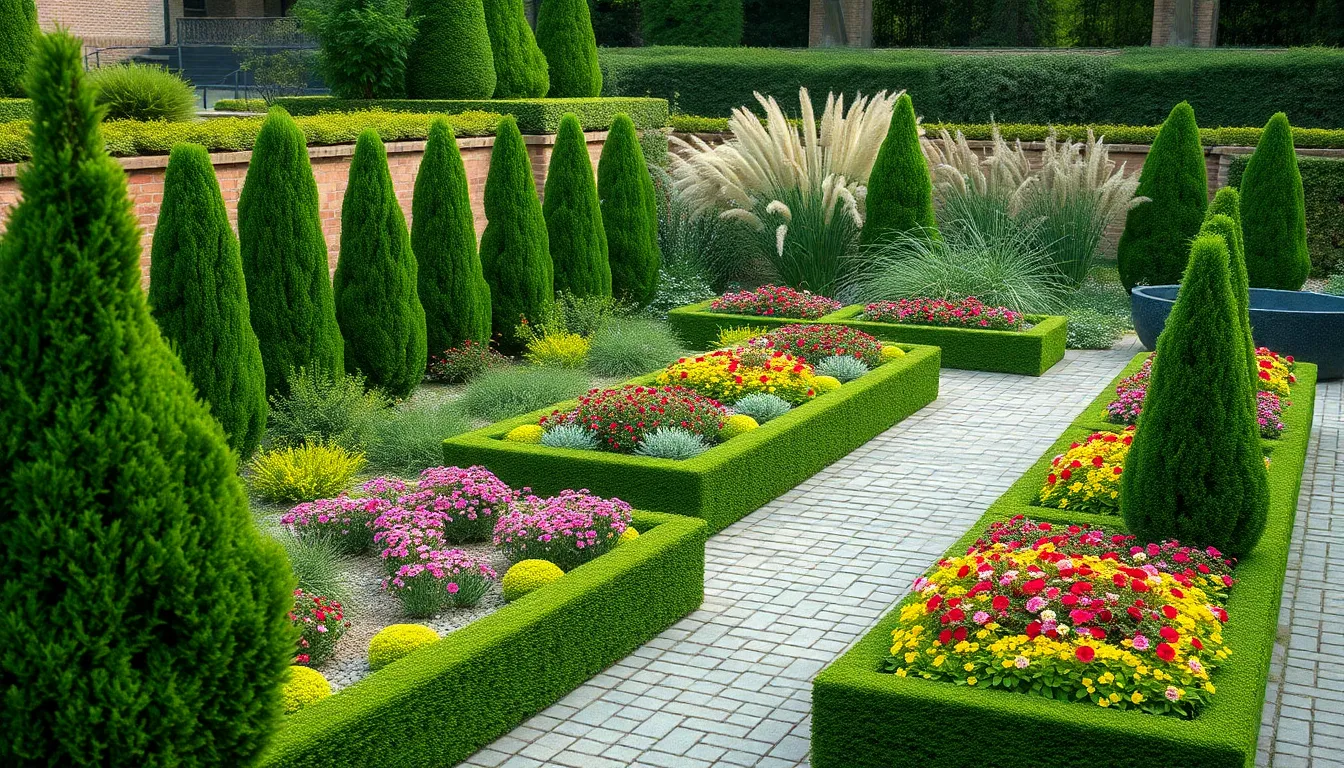
Selecting the right plants for rectangular gardens requires careful consideration of how each variety will interact with the space’s natural linear structure. We’ll focus on plants that enhance rather than fight against the geometric lines while creating visual harmony throughout your outdoor sanctuary.
Select Plants That Complement Linear Garden Lines
Topiaries serve as living sculptures that reinforce the geometric nature of rectangular spaces. We recommend positioning these carefully shaped evergreens at key transition points between garden zones or as anchor plants near seating areas. Box hedging and privet respond exceptionally well to regular pruning and maintain their structured appearance year round.
Columnar shrubs create natural vertical elements that emphasize the garden’s linear flow. Juniper varieties like ‘Skyrocket’ and ‘Blue Point’ work excellently along fence lines or property boundaries. These upright growers add height without spreading horizontally into valuable planting space.
Hanging planters maximize vertical growing space while maintaining clean ground level sight lines. We suggest installing these along pergola beams or fence tops using trailing plants like ivy geraniums or cascading petunias. This approach adds greenery to boundaries without consuming precious floor space for other garden elements.
Use Ornamental Grasses for Natural Borders
Ornamental grasses provide texture and movement that soften the hard edges of rectangular garden layouts. Fountain grass (Pennisetum) creates flowing borders that guide the eye along pathways while maintaining the garden’s structured appearance. These versatile plants come in heights ranging from 12 inches to 4 feet, allowing for layered plantings that add depth.
Feather reed grass (Calamagrostis) offers exceptional vertical interest with its narrow, upright growth habit. We plant these in repeating groups along the garden’s longer edges to create rhythm and visual continuity. The golden seed heads persist through winter, providing four season appeal.
Blue fescue (Festuca glauca) works perfectly as edging plants along pathways and planting bed borders. These compact, blue gray tufts maintain their color throughout the growing season and require minimal maintenance once established.
Plant Seasonal Flowers for Year-Round Color
Creating continuous color requires strategic seasonal planning that ensures blooms throughout the growing year. Repeat flowering roses provide reliable color from late spring through fall frost, making them ideal anchor plants for rectangular garden schemes. We recommend varieties like ‘Knock Out’ and ‘Flower Carpet’ series for their disease resistance and extended blooming periods.
Hardy geraniums bridge the gap between spring bulbs and summer annuals with their long flowering season. These perennials bloom from early summer through fall and tolerate both full sun and partial shade conditions. Varieties like ‘Rozanne’ and ‘Bloomtime’ offer months of continuous color.
Spring bulbs including tulips and daffodils should be planted in geometric patterns that echo the garden’s linear structure. We suggest creating straight rows or rectangular blocks of single colors rather than mixed informal drifts. This approach reinforces the garden’s architectural qualities while providing early season color.
Summer annuals like sunflowers and zinnias can be planted in designated cutting garden areas within the rectangular layout. These provide bright colors during peak growing season and serve dual purposes as both ornamental and functional plants for indoor arrangements.
Conclusion
We’ve shown you that rectangular gardens aren’t limitations – they’re opportunities waiting to be discovered. With thoughtful zoning strategic pathways and vertical elements your narrow space can become a stunning outdoor retreat that rivals any traditional garden layout.
The key lies in embracing your garden’s natural structure while adding layers of interest through water features corner transformations and carefully selected plants. These design principles work together to create depth movement and functionality in even the most challenging rectangular spaces.
Your rectangular garden has the potential to become your favorite outdoor sanctuary. Start with one or two of these ideas and gradually build upon your success – you’ll be amazed at how quickly your space transforms into something truly extraordinary.
Frequently Asked Questions
What are the main benefits of having a rectangular garden?
Rectangular gardens offer excellent opportunities for creating defined zones, establishing visual depth, and maximizing functional space. Despite their linear shape, they can be transformed into beautiful outdoor sanctuaries with strategic design. They’re ideal for organizing different areas like dining, relaxation, children’s play, and vegetable growing while maintaining clear sight lines and easy navigation throughout the space.
How can I create different zones in my rectangular garden?
Divide your space into functional areas: position dining zones near the house for convenience, create quiet relaxation areas with fire pits or water features, designate sunny spots for children’s play equipment, and establish separate areas for vegetable and herb growing. Use raised beds, pergolas, and low-growing plants as natural dividers to visually separate each zone while maintaining flow.
What types of pathways work best in rectangular gardens?
Straight central walkways provide easy navigation and emphasize the garden’s linear structure. Curved paths can soften angular edges for a more organic feel, while stepping stone trails through planting beds offer practical maintenance access. Ensure pathways are wide enough for comfortable movement and consider materials that complement your overall garden aesthetic.
How do I add height and visual interest to a flat rectangular space?
Incorporate vertical elements like trellises along fence lines for climbing plants, install pergolas to define spaces and provide shade, and plant climbing vines on garden walls. Consider specimen trees in corners for dramatic focal points and use columnar shrubs or topiaries to enhance the garden’s geometric lines while adding much-needed vertical dimension.
What planting strategies work best for rectangular gardens?
Use symmetrical planting schemes with mirrored arrangements on opposite sides to create visual balance. Incorporate ornamental grasses for natural borders, plant seasonal flowers in geometric patterns, and use repeating groupings to establish rhythm. Select plants that complement the linear structure, such as columnar shrubs and topiaries, while planning for year-round color rotation.
How can I make the most of corner spaces in my rectangular garden?
Transform corners into cozy seating nooks with comfortable furniture and stepping stone access. Plant specimen trees for dramatic focal points and underplant with shade-loving perennials. Install vertical storage solutions like wall-mounted shelving or hidden storage benches. These often-overlooked spaces can become charming focal points that enhance your garden’s overall functionality and visual appeal.
What water features work well in rectangular gardens?
Rectangle-shaped ponds or fountains maintain clean geometric lines while adding visual interest. Place them centrally for maximum impact. Small water gardens in corner spaces transform underutilized areas into focal points. Stream-like water elements along pathways introduce movement and soothing sounds while guiding visitors through the garden and maintaining clear navigation routes.
